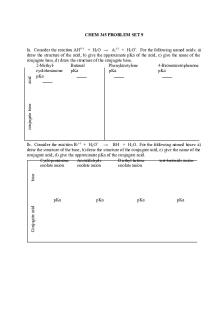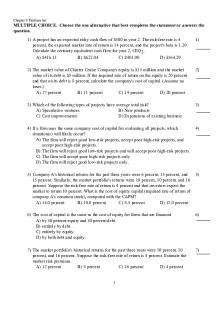SET 9 - Hauer PDF

| Title | SET 9 - Hauer |
|---|---|
| Course | Applied Microbiology |
| Institution | Nova Southeastern University |
| Pages | 7 |
| File Size | 64.7 KB |
| File Type | |
| Total Downloads | 44 |
| Total Views | 158 |
Summary
Hauer...
Description
SET 9 Paul Ehrlich 1904 - developed concept of selective toxicity and effectively treated African sleeping sickness
Sahachiro Hato 1910 - effectively treated syphilis
Domagk, Jacques, and trefouel 1935 - discovered sulfa drugs
Ernest Duchesne 1896 - first discovered penicillin but was lost
Alexander Fleming 1928 - credited with discovery of penicillin
Florey, Chain, and Heatley 1939 - demonstrated effectiveness of penicillin and won nobel prize
Selman Waksman 1944 - discovered streptomycin and won nobel prize
ability of drug to kill or inhibit pathogen while damaging host as little as possible Define selective toxicity
grug level required for clinical treatment Define therapeutic dose
drug level at which drug becomes too toxic for patient
Define toxic dose
ratio of toxic dose to therapeutic dose Define therapeutic index
undesireable effects of drugs on host cells Define side effects
attack only a few different pathogens Define narrow-spectrum drugs
attack many different pathogens Define broad-spectrum drugs
kills microbes Define cidal agent
inhibits growth of microbes Define static agent
cidal Is penicillin static or cidal?
lowest concentration of drug that inhibits growth of pathogen Define minimal inhibitory concentration (MIC)
lowest concentration of drug that kills pathogen Define minimal lethal concentration (MLC)
innoculate media with dif concentrations of drug and plate with lowest concentration that showed no growth is MIC Describe dilution susceptibility tests
discs with drugs are placed in petri dishes with a lawn of bacteria, drug diffuses into agar and absorbed by cells which is lethal Describe disk diffusion tests
clear zones of no growth around disks Define zone of inhibition
Kirby-Bauer Method What is the most common disk diffusion test?
E test
Inhibit cell wall, protein, and nucleic acid synthesis as well as block metabollic pathways What are 4 ways drugs affect microbes?
beta-lactam group of antibiotics
cell wall synthesis inhibitors How do beta-lactam antibiotics work?
produce beta-lactamases (penicillinases) which hydrolyze the beta-lactam ring of the drugs How do cells become resistant to beta-lactam antibiotics?
block enzymes that catalyze transpeptidation bonds between peptidoglycan preventing cell wall synthesis and eventual lysis of cell How do penicillins work?
acts only on growing cells What is one drawback of penicillin?
1-5% What percentage of adults in US are allergic to penicillin?
cephalosporins A broad-spectrum antibiotic that can be used by patients that are allergic to penicillin
vancomycin drug of last resort, inhibitor of cell wall synthesis, important in treatment of antibiotic resistant staphylococcal and enterococcal infections
penicillins cephalosporins vancomycin teicoplanin Name 4 drugs that inhibit cell wall synthesis
bind to 30S subunit of ribosome and inhibit translation How do aminoglycoside antibiotcs work?
tetracylcine broad spectrum, bacteriostatic antibiotic that inhibits translation, used to treat acne
tetracycline macrolides chrloramphenicol Name 3 antibiotics that inhibit translation
competitively bind to enzymes blocking pathway How inhibitors of metabolic pathways work?
sulfa drugs trimethoprim Name 2 drugs that inhibit metabolic pathways
inhibit DNA or RNA polymerase or DNA helicase Describe how inhibitors of nucleic acid synthesis works
quinolone Name a drug that inhibits nucleic acid synthesis
fungal cell morphology similiar to human cells Why is treating fungal infections so difficult?
a disease caused by infection with a fungus Define mycoses
inhibit sterol, protein, and DNA synthesis How would a mycoses affect host cells?
amphotericin B 5-flucytosine
fluconazole Name 3 drugs commonly used to treat mycoses
tamiflu drug given to patients if in early stages of flu
inhibitors of reverse transcriptase, fusion, and protease What are 3 mechanisms anti-HIV drugs target?
cocktails of drugs In all cases of treating infections, what have proven to be the most effective treatment?
ability of drug to reach site of infection susceptibility of pathogen to drug ability of drug to exceed MIC What are the main factors influencing the effectiveness of antimicrobial drugs
Arise spontaneously from mutations and are then selected for How does resistance originate?
cocktails of drugs use drugs only when necessary new drugs bacteriophages Describe some ways of overcoming drug resistance
lots of organisms in nature produce natural antimicrobial molecules Where did antimicrobial drugs originate?
satellite colonies What are colonies called that grow in the zone of inhibition?
amino acids - most are made from other organisms, these drugs go into cells and perform a function Most antibiotics can be classified as what types of molecules?
a substrate that has a higher affinity for an enzyme than its natural substrate Define competitive inhibitor
an enzyme that relieves strain while double-strand DNA is being unwound by helicase by introducing negative supercoiling of the circular DNA to counteract the positive supercoiling strain placed on the DNA, performed before replication Describe the function of DNA gyrase
hydrophobic Are most drugs hydrophilic or hydrophobic?
viruses that have single host organisms or mutate slowly What kind of viruses are easy to vaccinate against
large number of antibiotics needed to kill bacteria only one bacteriophage needed to kill bacteria Why are bacteriophages more effective than antibiotics?...
Similar Free PDFs

SET 9 - Hauer
- 7 Pages

SET 5 - Hauer
- 20 Pages

Problem set 9 sheet
- 2 Pages

SET 9 - Omar Eldakar
- 9 Pages

SET 9 - Mariam Harkas
- 7 Pages

Problem set 9 - Questions
- 3 Pages

Problem Set 9-Solutions
- 6 Pages

Chapter 9 Problem Set
- 6 Pages

Problem Set 9 (Answers)
- 12 Pages

PHIL 130- question set 9
- 2 Pages

Set-9-solutions - tute solutions
- 4 Pages

Private Study Questions Set 9
- 2 Pages
Popular Institutions
- Tinajero National High School - Annex
- Politeknik Caltex Riau
- Yokohama City University
- SGT University
- University of Al-Qadisiyah
- Divine Word College of Vigan
- Techniek College Rotterdam
- Universidade de Santiago
- Universiti Teknologi MARA Cawangan Johor Kampus Pasir Gudang
- Poltekkes Kemenkes Yogyakarta
- Baguio City National High School
- Colegio san marcos
- preparatoria uno
- Centro de Bachillerato Tecnológico Industrial y de Servicios No. 107
- Dalian Maritime University
- Quang Trung Secondary School
- Colegio Tecnológico en Informática
- Corporación Regional de Educación Superior
- Grupo CEDVA
- Dar Al Uloom University
- Centro de Estudios Preuniversitarios de la Universidad Nacional de Ingeniería
- 上智大学
- Aakash International School, Nuna Majara
- San Felipe Neri Catholic School
- Kang Chiao International School - New Taipei City
- Misamis Occidental National High School
- Institución Educativa Escuela Normal Juan Ladrilleros
- Kolehiyo ng Pantukan
- Batanes State College
- Instituto Continental
- Sekolah Menengah Kejuruan Kesehatan Kaltara (Tarakan)
- Colegio de La Inmaculada Concepcion - Cebu



